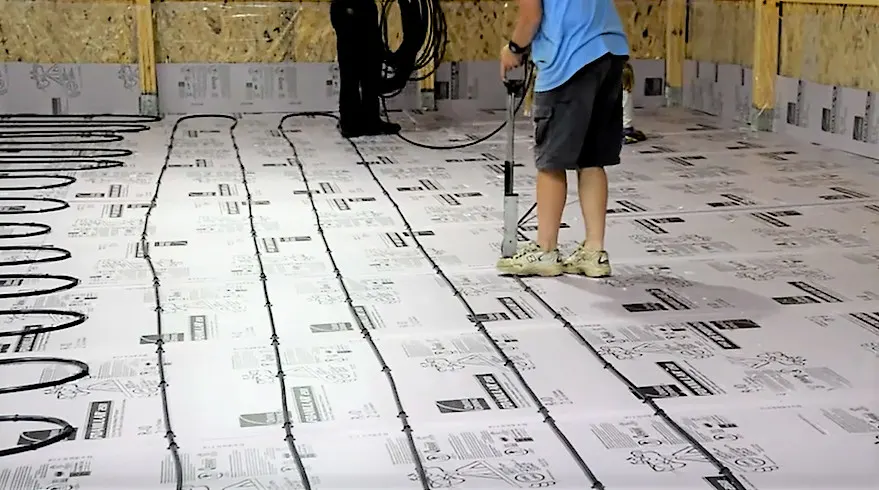
Here in the mountains of North Carolina where BarndominiumLife.com originates — improbably — we sometimes get the tail end of brutal Nor’Easters that bring snowy circumstances to the states farther north of us.
We don’t escape the consequences either, although arguably the winds — sometimes clocked at 60 mph for hours on end — can get your attention faster than 1 foot snowfalls and temperatures frequently in the low teens.
All the more reason to seriously think about heating your barndo from the ground up, as so many folks are doing these days, and for good reason.
Heated Concrete Floors: Do They Really Make a Difference? Studies have shown that you can save energy and create a healthier, more comfortable living environment by having the floor itself distribute the heat — from the ground up –via a radiant in-floor heating system.
Page Contents
More conventional heating systems are no longer dominant
Forced air systems have kind of gone by the wayside as more and more barndominium owner-builders think a long way ahead — laying out the black tubing in a back-and-forth pattern to get the most benefit from their in-floor heating systems.
The rationale underlying the practice is not exactly rocket science,
Tubing circulates hot water embedded in a concrete slab, or in some cases, electrical heating elements, resulting in a toasty warm surface even for sockless feet on these deep freeze mornings,
And not only are your feet warm. The rest of your body is comfortable, even in barndos with no other heating system.
This can of course also result in drastically reduced energy costs in the winter.
And while this kind of thing makes the most sense for installation in the pre-construction phase of building your dream barn home, you can also retrofit an existing floor with radiant heat via gypsum overlays or newer methods of embedding warming tubes or coils beneath — or rather inside — your current floor.
Concretenetwork.com explains:
“What if you have an existing concrete floor? Radiant heating is still an option.
“Newer ultra-thin electric heating mats are available that can be embedded in thin-set cement or gypsum overlays, allowing retrofitting over existing slabs without significantly raising the floor height.”
That article goes on to offer information on
- exactly what radiant in-floor heating is,
- how it works,
- the benefits of radiant heat and
- where to find installers.
Here’s another way of looking at it
The Radiant Panel Association offers a still more compelling visualization of the process: Hold your hand over a cup of coffee and feel the heat. The logical conclusion is that heat rises.
Logical maybe, but incorrect, they say.
“‘Hot air’ rises but ‘heat’ can travel in many directions. That is why you can feel the heat of the coffee cup when you place your hand to the side of it. Radiant energy transfer is caused by a warm surface giving up its heat to a cooler surface.”
Consider, the Association spokesperson goes on, how the sun (10,000° F) heats the earth (61° F ). “The sun radiates its energy towards the earth. The radiant energy is absorbed by the earth and is released as heat.
“A radiant floor heating system simply radiates heat upward from the floor to provide optimum comfort and many other benefits.”
Benefits of heated concrete floors
Here’s an excellent video in which the narrator is installing a heated floor inside the foundation of a Morton Buildings frame of unknown dimensions. All we know is, it’s big.
And while this young man, who clearly knows what he’s doing and provides chapter and verse on the best way to underlie a concrete floor for farm animals and tractors, we wonder — why would they need a $10,000 heated floor for that purpose anyway?
But his uber-detailed explanation and incredibly high viewer count on YouTube show his clear expertise at installation of tubing over a wide area is admired by at least a half million viewers.
We include it here only because his astonishingly thorough radiant heat installation process can be put to good use by anyone who has erected a metal frame shell of any size — particlarly those who will be finishing it out as a first-class barn home or barndominium with heated floors.
Here’s the 11-minute video, packed solid with at least two hours of detailed installation knowledge. You’ll quickly see what we mean.
We sincerely hope it’s of value.
